Rafet Sifa
A Survey on Current Trends and Recent Advances in Text Anonymization
Aug 29, 2025Abstract:The proliferation of textual data containing sensitive personal information across various domains requires robust anonymization techniques to protect privacy and comply with regulations, while preserving data usability for diverse and crucial downstream tasks. This survey provides a comprehensive overview of current trends and recent advances in text anonymization techniques. We begin by discussing foundational approaches, primarily centered on Named Entity Recognition, before examining the transformative impact of Large Language Models, detailing their dual role as sophisticated anonymizers and potent de-anonymization threats. The survey further explores domain-specific challenges and tailored solutions in critical sectors such as healthcare, law, finance, and education. We investigate advanced methodologies incorporating formal privacy models and risk-aware frameworks, and address the specialized subfield of authorship anonymization. Additionally, we review evaluation frameworks, comprehensive metrics, benchmarks, and practical toolkits for real-world deployment of anonymization solutions. This review consolidates current knowledge, identifies emerging trends and persistent challenges, including the evolving privacy-utility trade-off, the need to address quasi-identifiers, and the implications of LLM capabilities, and aims to guide future research directions for both academics and practitioners in this field.
Reasoning LLMs in the Medical Domain: A Literature Survey
Aug 26, 2025Abstract:The emergence of advanced reasoning capabilities in Large Language Models (LLMs) marks a transformative development in healthcare applications. Beyond merely expanding functional capabilities, these reasoning mechanisms enhance decision transparency and explainability-critical requirements in medical contexts. This survey examines the transformation of medical LLMs from basic information retrieval tools to sophisticated clinical reasoning systems capable of supporting complex healthcare decisions. We provide a thorough analysis of the enabling technological foundations, with a particular focus on specialized prompting techniques like Chain-of-Thought and recent breakthroughs in Reinforcement Learning exemplified by DeepSeek-R1. Our investigation evaluates purpose-built medical frameworks while also examining emerging paradigms such as multi-agent collaborative systems and innovative prompting architectures. The survey critically assesses current evaluation methodologies for medical validation and addresses persistent challenges in field interpretation limitations, bias mitigation strategies, patient safety frameworks, and integration of multimodal clinical data. Through this survey, we seek to establish a roadmap for developing reliable LLMs that can serve as effective partners in clinical practice and medical research.
Interpretable Topic Extraction and Word Embedding Learning using row-stochastic DEDICOM
Jul 22, 2025Abstract:The DEDICOM algorithm provides a uniquely interpretable matrix factorization method for symmetric and asymmetric square matrices. We employ a new row-stochastic variation of DEDICOM on the pointwise mutual information matrices of text corpora to identify latent topic clusters within the vocabulary and simultaneously learn interpretable word embeddings. We introduce a method to efficiently train a constrained DEDICOM algorithm and a qualitative evaluation of its topic modeling and word embedding performance.
* Accepted and published at CD-MAKE 2020, 20 pages, 8 tables, 8 figures
Towards Automated Regulatory Compliance Verification in Financial Auditing with Large Language Models
Jul 22, 2025Abstract:The auditing of financial documents, historically a labor-intensive process, stands on the precipice of transformation. AI-driven solutions have made inroads into streamlining this process by recommending pertinent text passages from financial reports to align with the legal requirements of accounting standards. However, a glaring limitation remains: these systems commonly fall short in verifying if the recommended excerpts indeed comply with the specific legal mandates. Hence, in this paper, we probe the efficiency of publicly available Large Language Models (LLMs) in the realm of regulatory compliance across different model configurations. We place particular emphasis on comparing cutting-edge open-source LLMs, such as Llama-2, with their proprietary counterparts like OpenAI's GPT models. This comparative analysis leverages two custom datasets provided by our partner PricewaterhouseCoopers (PwC) Germany. We find that the open-source Llama-2 70 billion model demonstrates outstanding performance in detecting non-compliance or true negative occurrences, beating all their proprietary counterparts. Nevertheless, proprietary models such as GPT-4 perform the best in a broad variety of scenarios, particularly in non-English contexts.
* Accepted and published at BigData 2023, 10 pages, 3 figures, 5 tables
Advancing Risk and Quality Assurance: A RAG Chatbot for Improved Regulatory Compliance
Jul 22, 2025Abstract:Risk and Quality (R&Q) assurance in highly regulated industries requires constant navigation of complex regulatory frameworks, with employees handling numerous daily queries demanding accurate policy interpretation. Traditional methods relying on specialized experts create operational bottlenecks and limit scalability. We present a novel Retrieval Augmented Generation (RAG) system leveraging Large Language Models (LLMs), hybrid search and relevance boosting to enhance R&Q query processing. Evaluated on 124 expert-annotated real-world queries, our actively deployed system demonstrates substantial improvements over traditional RAG approaches. Additionally, we perform an extensive hyperparameter analysis to compare and evaluate multiple configuration setups, delivering valuable insights to practitioners.
* Accepted and published at BigData 2024, 3 pages, 3 tables, 2 figures
Judging Quality Across Languages: A Multilingual Approach to Pretraining Data Filtering with Language Models
May 28, 2025Abstract:High-quality multilingual training data is essential for effectively pretraining large language models (LLMs). Yet, the availability of suitable open-source multilingual datasets remains limited. Existing state-of-the-art datasets mostly rely on heuristic filtering methods, restricting both their cross-lingual transferability and scalability. Here, we introduce JQL, a systematic approach that efficiently curates diverse and high-quality multilingual data at scale while significantly reducing computational demands. JQL distills LLMs' annotation capabilities into lightweight annotators based on pretrained multilingual embeddings. These models exhibit robust multilingual and cross-lingual performance, even for languages and scripts unseen during training. Evaluated empirically across 35 languages, the resulting annotation pipeline substantially outperforms current heuristic filtering methods like Fineweb2. JQL notably enhances downstream model training quality and increases data retention rates. Our research provides practical insights and valuable resources for multilingual data curation, raising the standards of multilingual dataset development.
[Vision Paper] PRObot: Enhancing Patient-Reported Outcome Measures for Diabetic Retinopathy using Chatbots and Generative AI
Nov 05, 2024Abstract:We present an outline of the first large language model (LLM) based chatbot application in the context of patient-reported outcome measures (PROMs) for diabetic retinopathy. By utilizing the capabilities of current LLMs, we enable patients to provide feedback about their quality of life and treatment progress via an interactive application. The proposed framework offers significant advantages over the current approach, which encompasses only qualitative collection of survey data or a static survey with limited answer options. Using the PROBot LLM-PROM application, patients will be asked tailored questions about their individual challenges, and can give more detailed feedback on the progress of their treatment. Based on this input, we will use machine learning to infer conventional PROM scores, which can be used by clinicians to evaluate the treatment status. The goal of the application is to improve adherence to the healthcare system and treatments, and thus ultimately reduce cases of subsequent vision impairment. The approach needs to be further validated using a survey and a clinical study.
Informed Deep Abstaining Classifier: Investigating noise-robust training for diagnostic decision support systems
Oct 28, 2024



Abstract:Image-based diagnostic decision support systems (DDSS) utilizing deep learning have the potential to optimize clinical workflows. However, developing DDSS requires extensive datasets with expert annotations and is therefore costly. Leveraging report contents from radiological data bases with Natural Language Processing to annotate the corresponding image data promises to replace labor-intensive manual annotation. As mining "real world" databases can introduce label noise, noise-robust training losses are of great interest. However, current noise-robust losses do not consider noise estimations that can for example be derived based on the performance of the automatic label generator used. In this study, we expand the noise-robust Deep Abstaining Classifier (DAC) loss to an Informed Deep Abstaining Classifier (IDAC) loss by incorporating noise level estimations during training. Our findings demonstrate that IDAC enhances the noise robustness compared to DAC and several state-of-the-art loss functions. The results are obtained on various simulated noise levels using a public chest X-ray data set. These findings are reproduced on an in-house noisy data set, where labels were extracted from the clinical systems of the University Hospital Bonn by a text-based transformer. The IDAC can therefore be a valuable tool for researchers, companies or clinics aiming to develop accurate and reliable DDSS from routine clinical data.
Pointer-Guided Pre-Training: Infusing Large Language Models with Paragraph-Level Contextual Awareness
Jun 06, 2024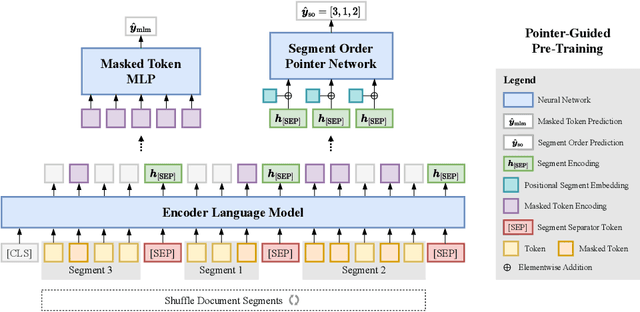
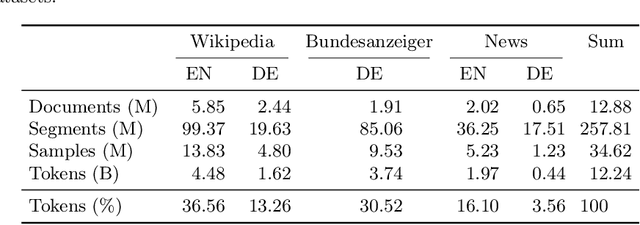
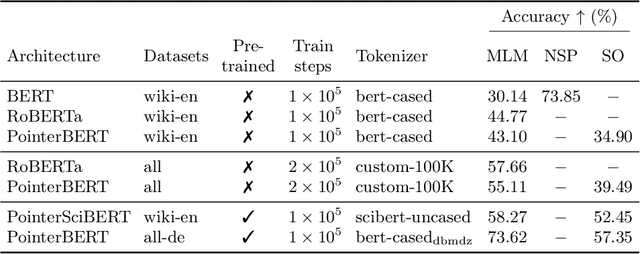
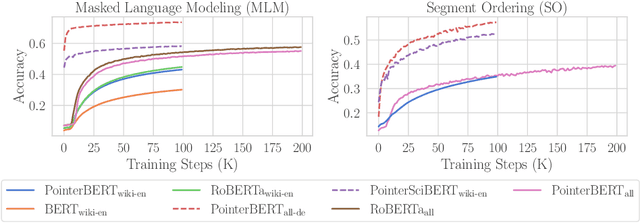
Abstract:We introduce "pointer-guided segment ordering" (SO), a novel pre-training technique aimed at enhancing the contextual understanding of paragraph-level text representations in large language models. Our methodology leverages a self-attention-driven pointer network to restore the original sequence of shuffled text segments, addressing the challenge of capturing the structural coherence and contextual dependencies within documents. This pre-training approach is complemented by a fine-tuning methodology that incorporates dynamic sampling, augmenting the diversity of training instances and improving sample efficiency for various downstream applications. We evaluate our method on a diverse set of datasets, demonstrating its efficacy in tasks requiring sequential text classification across scientific literature and financial reporting domains. Our experiments show that pointer-guided pre-training significantly enhances the model's ability to understand complex document structures, leading to state-of-the-art performance in downstream classification tasks.
Model-agnostic Body Part Relevance Assessment for Pedestrian Detection
Nov 27, 2023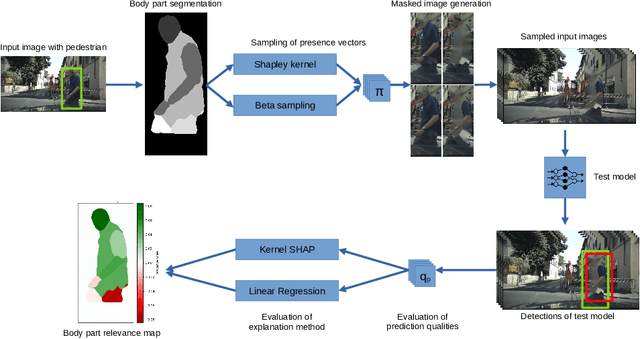
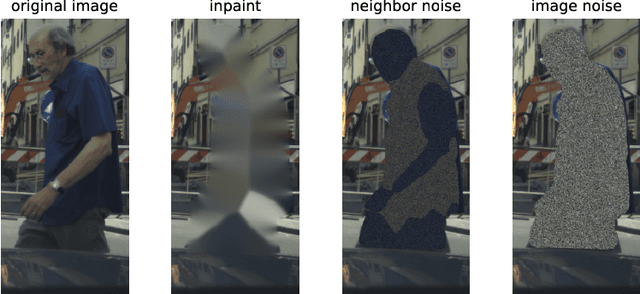
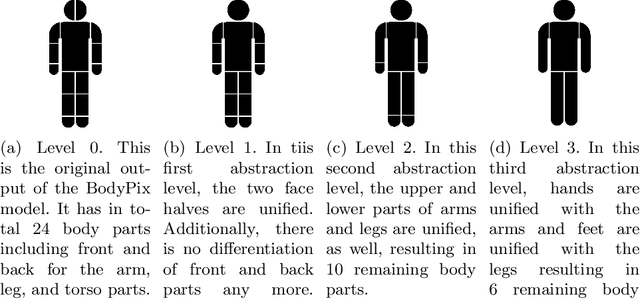
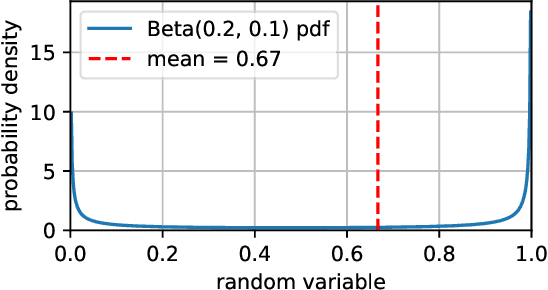
Abstract:Model-agnostic explanation methods for deep learning models are flexible regarding usability and availability. However, due to the fact that they can only manipulate input to see changes in output, they suffer from weak performance when used with complex model architectures. For models with large inputs as, for instance, in object detection, sampling-based methods like KernelSHAP are inefficient due to many computation-heavy forward passes through the model. In this work, we present a framework for using sampling-based explanation models in a computer vision context by body part relevance assessment for pedestrian detection. Furthermore, we introduce a novel sampling-based method similar to KernelSHAP that shows more robustness for lower sampling sizes and, thus, is more efficient for explainability analyses on large-scale datasets.
 Add to Chrome
Add to Chrome Add to Firefox
Add to Firefox Add to Edge
Add to Edge